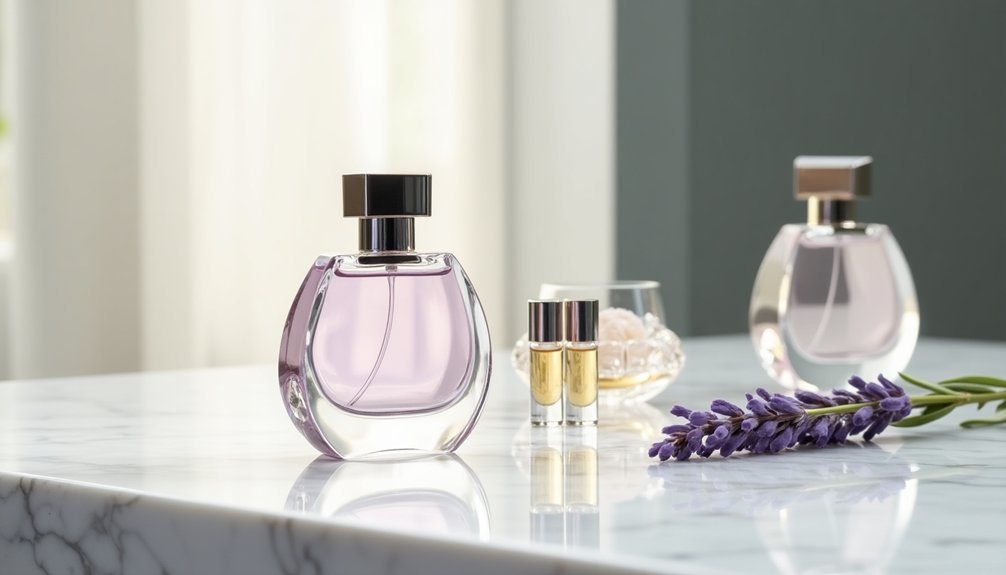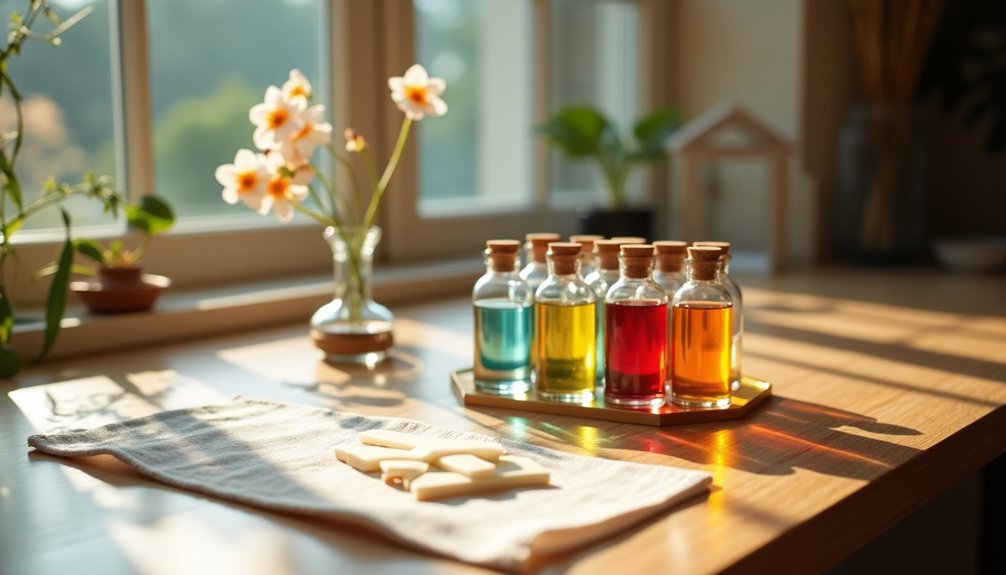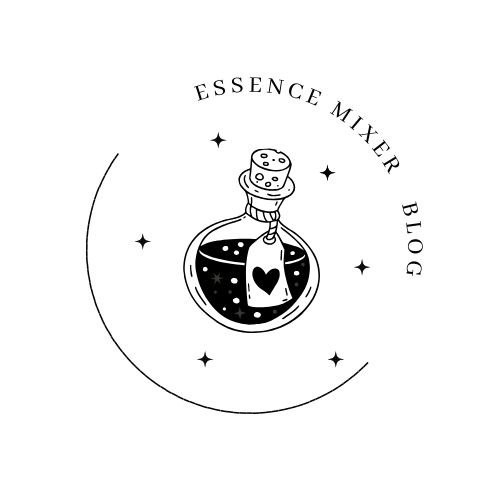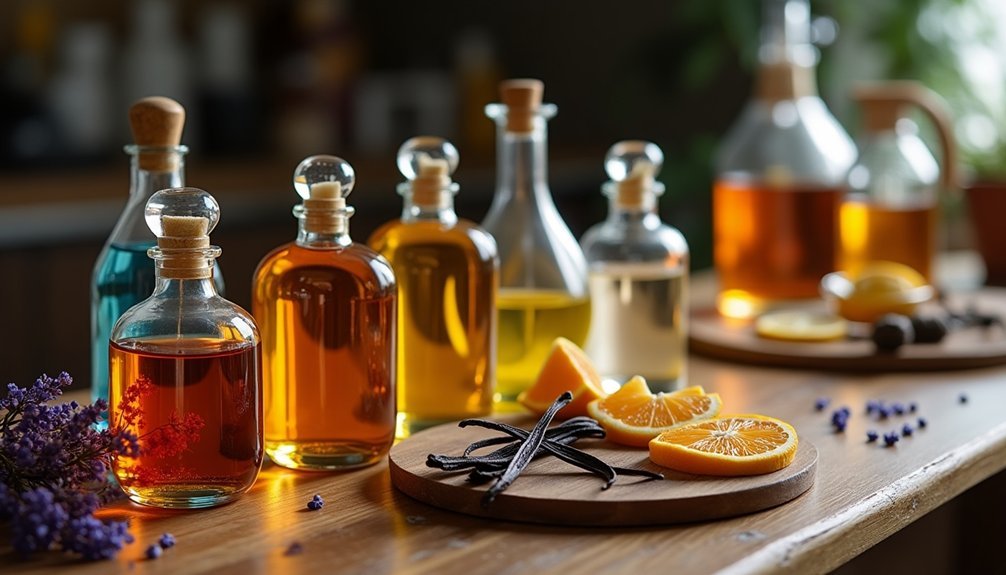To test perfumes like a pro, start with clean, fragrance-free skin and focus on pulse points for application. Don't test more than three scents per day to avoid nose fatigue, and skip the coffee beans – fresh air works better to reset your nose. Use blotter strips for initial impressions, then apply directly to skin to experience the true scent evolution. Track your fragrance journey in a detailed journal. The world of expert perfume testing holds many more secrets to discover.
Essential Tools for Professional Perfume Testing

When starting on professional perfume testing, you'll need several essential tools to guarantee accurate fragrance evaluation. Blotter strips are your primary instrument – hold them by the narrow end about an inch from your nose to detect the top notes immediately and allow the scent to settle.
Your clean skin serves as another vital testing surface, particularly your pulse points. Keep your wrists and behind-the-ear areas free from other products, especially in the morning when your nose is most sensitive.
You'll also want to collect small fragrance samples to evaluate how scents develop over time on your skin. Remember to limit yourself to testing three perfumes per day to prevent nose fatigue and maintain testing accuracy.
This methodical approach guarantees you'll capture each fragrance's true character.
The Science Behind Scent Evaluation
Perfume evaluation relies heavily on understanding the intricate relationship between body chemistry and fragrance molecules. Your unique body chemistry plays a significant role in how a scent profile develops, which is why you'll need to apply fragrances directly to your skin for accurate testing.
When evaluating perfumes, apply them to your pulse points but don't rub your wrists together, as this can damage the delicate scent molecules. You'll want to let each fragrance settle naturally to experience its complete evolution.
To preserve the integrity of your testing, limit yourself to three different perfumes per day. This prevents olfactory fatigue and allows you to fully appreciate how each scent transforms from its initial top notes through to its base notes over several hours.
Proper Skin Application Techniques

Successful fragrance testing starts with proper skin application. To get the most authentic scent experience, you'll want to begin with clean, fragrance-free skin.
Apply your test perfume directly to pulse points – wrists, behind the ears, and inner elbows – where your body's natural warmth will help release the fragrance.
For the truest scent experience, apply perfume to your pulse points where skin warmth naturally enhances the fragrance notes.
Don't rub your wrists together after applying the perfume, as this common mistake can actually break down the scent molecules and alter the fragrance's true character. Instead, let the scent settle naturally on your skin.
Test fragrances in the morning when your nose is most sensitive, and give each scent several minutes to develop on your skin. To prevent overwhelming your sense of smell, limit yourself to testing just three fragrances per day.
Understanding Fragrance Notes and Layers
When you test a new fragrance, you'll experience its transformative journey from bright top notes in the first 30 minutes through to the lasting base notes hours later.
The heart notes emerge as the initial burst fades, revealing the true personality of the perfume with its floral, fruity, or spicy core that defines the scent's character.
These three distinct layers work together to create a complete olfactory experience, with each note playing its essential role in the fragrance's composition from first spray to final dry-down.
Top-to-Base Note Evolution
Understanding a fragrance's journey begins with its three distinct layers: top, heart, and base notes.
When you first spray a perfume, you'll experience the top notes – light, fresh scents like citrus or herbs that last up to an hour. These fleeting notes create your initial impression before gracefully fading away.
As the top notes dissipate, the heart notes emerge as the fragrance's core personality. These middle notes, often floral or fruity, stick around for several hours and define the perfume's main character.
Finally, you'll discover the base notes, which form the fragrance's foundation. Rich ingredients like vanilla, musk, or amber provide lasting depth and stay with you the longest.
This evolution from top to base creates a dynamic scent experience that unfolds throughout your day.
Layering Essential Fragrance Notes
The art of layering fragrance notes requires a keen awareness of how different scent elements interact and evolve throughout the day. You'll want to understand how each layer contributes to your desired scent profile before combining fragrances.
| Layer | Duration | Best For |
|---|---|---|
| Top Notes | 5-15 minutes | First impressions |
| Heart Notes | 2-4 hours | Main character |
| Base Notes | 6-12 hours | Lasting memory |
| Balanced Mix | All day | Signature scent |
| Single Layer | Varies | Specific moments |
When layering, start with your base notes, allowing them to settle before adding heart notes. Finally, top with lighter, fresher scents. You'll find that some combinations work better than others, so don't be afraid to experiment. Remember that your body chemistry affects how each layer develops, making your layered creation uniquely yours.
Creating Your Perfect Testing Environment

Since testing perfumes requires a refined sense of smell, creating the right environment is essential for an accurate evaluation.
You'll want to guarantee proper ventilation to prevent scent buildup that can muddle your perception of each fragrance's unique scent profile. Choose a quiet, calm space where you can concentrate without distractions.
Before testing, remove any scented products from your skin to maintain neutrality.
You'll get the most accurate results by limiting yourself to three fragrances per day, as your nose needs time to reset between samples. Schedule your testing sessions for morning hours when your olfactory senses are sharpest after sleeping.
With these conditions in place, you're ready to assess each perfume's subtle notes and characteristics with expert precision.
Common Mistakes to Avoid During Testing
When testing perfumes, you'll want to avoid overwhelming your nose by limiting yourself to three fragrances per day and taking breaks with fresh air or water between samples.
Skip the myth of coffee beans as a palette cleanser, and instead rely on sniffing your unscented skin to reset your olfactory senses.
For accurate scent evaluation, apply perfumes directly to pulse points rather than creating a fragrance cloud to walk through, and never rub your wrists together after application.
Nose Fatigue Prevention Tips
As fragrance enthusiasts explore new scents, they often make mistakes that lead to nose fatigue and diminish their testing experience.
To maintain your ability to detect each scent profile accurately, you'll need to follow specific preventive measures.
Limit yourself to testing only three perfumes per day, and never spray multiple fragrances at once. Instead of relying on coffee beans, take short breaks between tests by stepping outside or drinking water to refresh your sense of smell.
You'll get the most accurate results by testing on clean skin during morning hours when your olfactory senses are sharpest. Make sure your skin is free from other fragrances, as lingering scents can interfere with your ability to evaluate new perfumes properly.
Proper Application Methods
Three critical mistakes often sabotage perfume testing experiences before they even begin. To master proper application methods, you'll need to avoid these common pitfalls that interfere with your skin chemistry and fragrance evaluation.
For accurate results, follow these essential steps:
- Apply perfume directly to clean, unscented pulse points.
- Never rub your wrists together after spraying.
- Test only one fragrance at a time.
Many people mistakenly believe walking through a fragrance mist or using coffee beans between tests will enhance their experience. Instead, stick to direct application on pulse points like wrists, behind ears, and inner elbows.
When you need to reset your nose, simply step outside for fresh air or smell unscented skin rather than relying on ineffective methods that can distort your perception.
The Art of Layering Multiple Scents
Although mastering a signature scent takes practice, layering multiple fragrances can transform your perfume game into an art form.
To discover your true essence, start with a beloved base fragrance, then strategically add lighter scents that complement its character. You'll want to pair florals with woody or citrus notes for a harmonious blend.
Start with a signature scent as your foundation, then thoughtfully layer complementary notes to create your own unique fragrance story.
Apply your base scent to pulse points first, then layer the lighter fragrance on top. Don't rush the process – experiment with different ratios by starting with one spray of base and gradually increasing the top notes.
Remember to choose fragrances with similar longevity to maintain consistency throughout wear. Always test your combinations directly on skin rather than paper strips, as your unique body chemistry will influence how the scents interact and evolve.
Time Management in Perfume Assessment
When testing multiple fragrances, proper time management becomes essential for an accurate assessment of each scent. To discover a perfume's true scent profile, you'll need to dedicate 15-30 minutes per fragrance and limit yourself to three tests daily.
For ideal results, schedule your testing sessions in the morning when your sense of smell is sharpest. Here's how to manage your time effectively:
- Start with blotter testing for initial impressions.
- Allow breaks between fragrances for sensory reset.
- Conclude with skin tests on pulse points.
Remember to cleanse your olfactory palette between scents by stepping outside or drinking water. This systematic approach prevents nose fatigue and guarantees you're experiencing each fragrance's complete evolution from top notes to base notes.
Recording Your Fragrance Journey
Keeping track of your fragrance experiences adds depth and purpose to your perfume testing journey. Start a detailed journal where you'll document your encounters with fragrance samples, noting how they evolve from top notes to base notes on your skin.
Documenting your fragrance journey transforms simple sampling into an art of discovery, revealing the unique story each scent tells on your skin.
Record essential details like application spots, weather conditions, and complementary body products you're using. Don't forget to note the date and occasion – these details help identify patterns in how perfumes perform for you.
Create a personal rating system that considers factors like mood enhancement and compliment frequency.
Make it a habit to revisit your journal entries regularly. You'll notice how your preferences shift over time, which will guide your future perfume selections more effectively.
This systematic approach transforms casual testing into a meaningful exploration of scents.
Building Your Scent Memory Bank
Start your scent memory training by journaling daily fragrance encounters, whether they're perfumes, essential oils, or everyday aromas you come across.
You'll strengthen your scent recognition by connecting fragrances to personal memories, like associating vanilla with your grandmother's kitchen or jasmine with summer evenings.
As you progress, challenge yourself to identify individual notes within complex perfumes, just as master perfumers do, which will enhance your ability to analyze and remember new scents.
Daily Scent Journal Exercises
Building a robust scent memory requires dedicated practice through daily journaling exercises. Your daily scent journal will sharpen your sense of smell while creating a personalized fragrance reference guide. Document each perfume's name, application method, and emotional response, along with its fragrance family and wearing occasion.
To maximize your journaling effectiveness:
- Rate each scent's performance metrics, including longevity and projection.
- Track how the fragrance evolves throughout the day on your skin.
- Note specific occasions where the perfume felt particularly suitable or unsuitable.
Review your entries regularly to identify patterns in your preferences and strengthen your scent recognition abilities.
This systematic approach helps you develop a sophisticated understanding of fragrances, making future perfume selections more intuitive and successful.
Sentimental Fragrance Memory Links
When you understand how scents forge powerful emotional connections, you'll discover why fragrance memories become treasured touchstones in your life. Your brain's olfactory bulb directly connects to your limbic system, making scent memories uniquely powerful and lasting.
To build your personal scent memory bank, deliberately choose perfumes for significant moments like weddings, milestone celebrations, or memorable trips. These fragrances become a true representation of your life's pivotal experiences.
When testing new perfumes, take time to reflect on the emotions and memories each scent triggers. Regularly revisit your signature scents to strengthen these emotional bonds.
You'll find that certain fragrances can instantly transport you back to cherished moments, helping reinforce your personal identity and creating a rich tapestry of olfactory memories.
Master Perfumer Note Recognition
Training your nose to recognize distinct perfume notes requires dedication and systematic practice, much like developing a wine connoisseur's palate. You'll build your scent memory through consistent exposure and mindful evaluation of fragrances using blotter strips to prevent sensory overload.
Start developing your expertise by:
- Maintaining a detailed fragrance journal to document note progressions and emotional connections
- Participating in professional workshops to understand scent families
- Practicing mindful analysis of how perfumes evolve on your skin
Don't rush the process – take time to experience how each fragrance unfolds from top notes through heart notes to base notes.
Your scent memory will strengthen as you regularly test and identify different notes, transforming abstract aromas into recognizable signatures you can confidently identify.
Mastering the Blotter Method
The blotter method stands as the gold standard for testing and evaluating perfumes, allowing you to experience each fragrance's true character without interference.
To master this technique, you'll need to handle the blotter correctly. Always grip the wider end, where you'll write the fragrance name, to prevent contamination. Dip only the narrow tip into the perfume, and hold it about an inch from your nose for the most accurate assessment.
Pay attention to how the scent evolves: catch the top notes right after application, wait a minute for the heart notes to emerge, and observe the base notes as time passes.
Advanced Testing for Complex Blends
Testing complex perfume blends requires a more sophisticated approach than the standard blotter method. To uncover a fragrance's true character, you'll need to apply it directly to your pulse points rather than paper strips, as your skin chemistry plays a vital role in how the scent develops.
When evaluating complex blends, follow these essential steps:
- Apply the fragrance to your wrists or behind your ears.
- Wait several minutes for the scent to settle and evolve.
- Track the fragrance's journey from top to base notes.
Remember to limit yourself to testing three different fragrances per day to maintain your olfactory sensitivity.
Pay close attention to how each scent projects and its longevity on your skin, as these factors reveal the true quality and complexity of the blend. Your body chemistry will uniquely interact with each fragrance, creating a personalized scent experience.
Frequently Asked Questions
What Is the 30 50 20 Rule for Perfume?
You'll create balanced fragrances by following the 30-50-20 rule: use 30% top notes for immediate scent, 50% heart notes for the main fragrance, and 20% base notes for lasting depth.
What Is the Best Way to Test Perfume?
Apply perfume to clean skin at pulse points, don't rub your wrists together, and test only three fragrances per day. Wait a few minutes between applications and reset your nose by sniffing unscented skin.
Do Tester Perfumes Smell Like the Original?
Yes, tester perfumes typically smell exactly like the original since they contain the same fragrance formula. You'll notice any differences are usually in packaging, not scent, though you should always test on your skin first.
What Is an Authentic US Tester Perfume?
An authentic US tester perfume is a genuine fragrance you'll find in retail stores for sampling. It's the same quality as regular versions but comes in simpler packaging and usually costs less than retail bottles.
In Summary
You're now equipped to test perfumes like a professional. By following proper application methods, understanding fragrance notes, and maintaining detailed records, you'll develop a refined nose for scents. Don't forget to trust your instincts while building your scent memory bank. Whether you're using blotters or testing on skin, you've got the essential tools to evaluate and blend fragrances with confidence.





Leave a Reply